Building and boarding a bigger boat together: Learning about sustainability through direct encounters with diverse people in our watershed
PDF: LauraYoder et al June 2013
Introduction
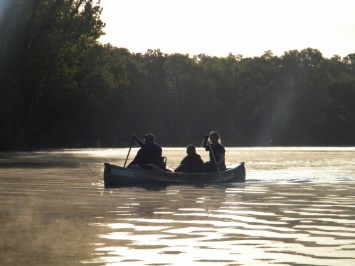
The sustainability movement needs a much bigger constituency. In the words of Richard Louv (2012), “we need a bigger boat” that includes more than the educators and environmentalists who are predisposed to agree with each other
about the importance of sustainability. Essential for this global movement to occur, and thus an integral part of sustainability education, is an ever-expanding and increasingly diverse network of people who are committed to creating a healthier future together. How can experiential sustainability education contribute to building a bigger boat, and to bringing more people on board?
We designed and implemented an interdisciplinary, residential Sustainability Semester premised on the expectation that building relationships with a wide variety of people will help undergraduates better understand the diversity of people that need to be part of building a sustainable society. Attention to communication skills across political and social boundaries gave students practical tools for contributing to this vision. We expected that direct encounters with others, and especially with those initially perceived as opponents, would build empathy and open the door to productive, transformative environmental communication across ideological divides and social differences. Effective environmental education is closely linked to learners’ everyday experiences in the ordinary environments they inhabit, and attends to affective as well as cognitive understandings of nature (Hungerford and Volk 1990, Louv 2005, Saylan and Blumstein 2011). Drawing on student notes and reflective writing, as well as faculty assessment, this paper outlines how an experiential, watershed-focused undergraduate program in sustainability helped students develop awareness of their place as residents of a watershed, and their part in working with a community towards sustainability.
Context
In the United States, many factors have limited the numbers and groups of people working together in social movements for sustainability. From the early years of the U.S. conservation movement, people-free wilderness ideologies have contributed to popular views of nature that focus on (so-called) pristine areas kept geographically separate from human settlements (Cronon 1995), isolating environmental concerns from the mainstream and from Main Street. Large conservation organizations have sometimes been zones of ethnic and socio-economic exclusivity or elitism, focusing on species-specific preservation in distant places rather than industrial contamination affecting communities of color closer to home (Enderle 2007, Sandler and Pezullo 2007); the resultant lack of cultural diversity in U.S. environmentalism reduces the nationwide social traction needed to address environmental issues (Bonta and Jordan 2007).
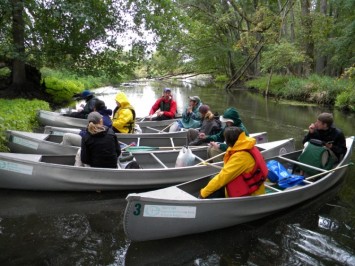 Decades of rise in literalist interpretations of scriptural texts created broad religious groupings for whom involvement in environmental action was not prioritized by trusted leadership, although this is now changing (Smith and Pulver 2009, Bouma-Prediger 2010, Lausanne 2012). Within some streams of environmental education, scientism has neglected the need for broad-based basic ecological awareness in society (Saylan and Blumstein 2011, Orr 1994). Persistent socio-cultural segregation in residential zones has given sectors of the U.S. population limited exposure to matters of environmental justice that can mobilize communities to work together for local ecological improvements.
Decades of rise in literalist interpretations of scriptural texts created broad religious groupings for whom involvement in environmental action was not prioritized by trusted leadership, although this is now changing (Smith and Pulver 2009, Bouma-Prediger 2010, Lausanne 2012). Within some streams of environmental education, scientism has neglected the need for broad-based basic ecological awareness in society (Saylan and Blumstein 2011, Orr 1994). Persistent socio-cultural segregation in residential zones has given sectors of the U.S. population limited exposure to matters of environmental justice that can mobilize communities to work together for local ecological improvements.
The typical residential college experience, in which undergraduates live on campus among a same-age demographic, can isolate students from their surroundings, limiting the learning they could gain by broader engagement with off-campus society and the natural world. In developing a Sustainability Semester in Residence (SSR) program at Goshen College, we explicitly aimed to equip students with transferable skills for building inclusive, sustainable communities.[1] Two central elements were building a sense of place and personal interactions with a representatively broad spectrum of people active in a watershed. The geographic classroom for the program is the watershed of the St. Joseph and Elkhart Rivers, with headwaters on the College property and the river mouth emptying into Lake Michigan some 100 miles northwest.
Based at the Merry Lea Environmental Learning Center of Goshen College, we had the benefit of a strongly enabling institutional environment. Goshen College is a small liberal arts college affiliated with the Mennonite Church, which has a long tradition of grassroots work in areas of chronic injustice, conflict, and need, alongside esteem for simple lifestyles and strong community relationships. One of the hallmarks of Goshen College is education for social justice that is well integrated with faith practice. Students encounter this emphasis throughout their undergraduate years both in and out of the classroom. From 1968, the College was among the earliest in the nation to require cross-cultural experiences for all students, typically placing them in simple homestays to work alongside local organizations; the experience incorporates introspection and group conversation on privilege, equity, hospitality, consumerism, and the various forms of poverty and affluence. The College’s core values include producing “compassionate peacemakers” and “global citizens,” and these themes have high profiles on campus with annual emphases and associated activities. For many at Goshen College, environmental concern grows directly from a faith-based commitment to social justice.
These values informed the design of the Sustainability Semester. Throughout the program, we sought to ground broad-based sustainability in terms of social justice for all people in a watershed. Too often, sustainability is perceived as an optional lifestyle for those who can install new appliances, afford high-end green technologies, and shop at boutique grocery stores. Instead, the critical questions we asked included the economics and geographies of access to healthy, local foods; the availability of safe and comfortable housing for people in vulnerable groups, and for those with disparate cultural expectations around housing; and how upstream and downstream water users negotiate water quality.
In the months leading up to the program’s launch, we initiated relationships with potential contacts for interactions throughout the semester. Phone calls led to face-to-face meetings, which evolved into field trip visits. This initial networking proved invaluable in familiarizing ourselves with the players and issues of our region, as well as in educating our neighbors about the Sustainability Semester’s purpose and ambitions. Making the effort to introduce and to integrate ourselves as citizens in the watershed allowed us to set the stage for our students to engage quickly and productively with their many hosts and visitors.
Program overview: Encountering diversity in our watershed
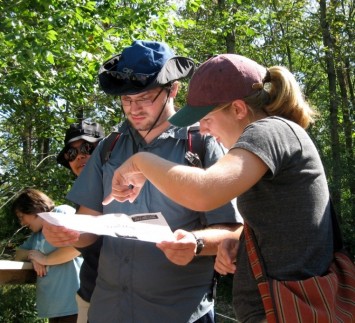 As part of the program, students committed to give close attention to their residential life together as part of their learning about building sustainable communities, in which they share decision making around common resources, use of space, communal meals, duties, and other areas. Forming this cohesive base of community enabled them to personally experience the challenges inherent in communicating and coming to agreed-upon action on sustainability issues. Moreover, this provided an empathetic and supportive setting in which the students could incorporate more challenging sustainable behaviors into their lifestyles. Students also maintained a stable home reference point from which they would encounter a wide diversity of people in our community, and the residential format allowed them extended discussion time around a set of common experiences.
As part of the program, students committed to give close attention to their residential life together as part of their learning about building sustainable communities, in which they share decision making around common resources, use of space, communal meals, duties, and other areas. Forming this cohesive base of community enabled them to personally experience the challenges inherent in communicating and coming to agreed-upon action on sustainability issues. Moreover, this provided an empathetic and supportive setting in which the students could incorporate more challenging sustainable behaviors into their lifestyles. Students also maintained a stable home reference point from which they would encounter a wide diversity of people in our community, and the residential format allowed them extended discussion time around a set of common experiences.
The program consisted of five courses,[2] co-led by a team of five faculty and one staff member over the course of fourteen weeks. The semester began with Headwaters Week, in which students got to know each other and the landscape at Merry Lea through hikes, a campout, and a canoeing tutorial in the lake that forms the headwaters of the river we would canoe. This week also included orientation sessions to the political, philosophical, biophysical, and socioeconomic methods they would be using during the semester, including the following: a “policy walk” during which they learned to discern the impact that policies have on the landscape around them; how to conduct basic water quality tests; an overview of ethical approaches to environmental issues; and interviewing practice in fishbowl style. Students also started practicing their note taking in handwritten journals, and reflective interdisciplinary commentaries as required throughout the semester.
In this first week, we foregrounded the importance of environmental communication across difference at the program’s outset. We reviewed and discussed the written portion of our guiding program policies that reads as follows:
“In this semester, all learners will certainly encounter people with habits, ideologies, interpretations, and viewpoints very different from our own, and which are as important to them as yours are to you. As a group we will develop expectations and strategies for dealing with this situation. Throughout the program, we will be intentionally noting the reasons and causes people give for their commitments, attitudes, and practices relevant to sustainability. Learning to effectively communicate your commitments, and to graciously interact with those who hold different views, is an important part of sustainability studies. We will also be alert to how different people we meet seek to communicate and convince—or not—about these aspects. Come prepared to change your own mind as you learn.”
We followed this with an exercise in which each student related three stories: 1) an account of a time in which the student was caused to change her or his mind about some issue related to sustainability, noting what it was that prompted the change; 2) an area in which each student was not yet personally living up to the sustainability ideal he or she had, noting what factors limited living up to this ideal at present; and 3) an incident in which each student made an effort to communicate a deeply held belief about ecologically responsible lifestyle choices to another person, with a description of the resulting response or interaction. Group reflection on this exercise served several important purposes in the program. First, students were aware that they have already been givers and receivers of environmental communication, with results that prompted behavior change or sometimes resulted in negative interactions or personal misunderstandings. Second, we explicitly acknowledged that none of us has achieved perfection in living sustainably, and thus we should approach our encounters with others’ views with appropriate humility. Third, we acknowledged that not all communication will nudge toward positive change, and thus we explicitly recognized the importance of improving our practice in this arena. We referred back to these stories at opportune times throughout the semester.
The second week was Downstream week, six days during which students and faculty canoed down segments of the Elkhart and then St. Joseph Rivers, which empty into Lake Michigan. Paddling was interspersed with two to four stops per day to meet people living and working near the river in a wide variety of roles. During this week, students met with the following array of people, among others: river health advocates from citizens’ groups, officials from county government and an interstate regional planning commission, small-scale organic farmers and a college-based sustainable agriculture training program, a church that became involved in river clean-ups and citizen science monitoring because they wanted to perform baptisms in the contaminated Elkhart River, soil and water conservation district staff, a public university building a sustainability center along the river, city hydropower authorities, a small-scale wastewater treatment plant, a green energy marketer, a theological scholar who specializes in water justice, a gravel pit operator, and a CAFO-style (concentrated animal feeding operation) dairy. In addition to these interactions, we noted and discussed the changing socioeconomic and demographic characteristics of regions through which we canoed, and twice daily took physical measurements of water quality.
The remainder of the semester was divided into course blocks, culminating in small group projects for the integrative Environmental Problem Solving course that students developed over the entire semester. During the course blocks, students made field visits or met in class with people active in the topics of each course. One to two full days per week were used for field trips. Students interacted with a conservative lobbyist and the mayor of a large city; diverse small business owners who sell bread, local foods, and septic systems; farmers producing meat, vegetables, honey, and value-added products; a municipal combined sewer overflow holding facility; staff from a county health department and the Indiana Department of Natural Resources; a local lake association meeting; pastors of conservative local churches; an award-winning health care and community development center for the uninsured; the zoning board; organizations active in building and renovating housing for low-income people; and an industrial seed corn plant, accompanied by a state agricultural extension agent.
For the Environmental Problem Solving course, students worked in tandem with local organizations to develop sustainability programs and public education plans for schoolyard tree studies with a nearby elementary school, a stormwater reduction study for the College’s town campus, and collaborations around a newly-expanding historic landmark and conservation center to promote the vitality of small-scale organic agriculture in the region. Through these projects, students gained practical skills and worked on actual local issues of environmental concern, learning about the opportunities and limitations directly from individuals and groups engaged in these arenas on a professional level. Even though all of the students in this semester were science majors and operated most readily from that perspective, each project grew to include very concrete and important social justice implications that would have been much more ephemeral without their ongoing dialogue with other people in the watershed, both from their partner agencies and beyond. For instance, the group promoting organic agriculture included provisions for lower-income families to increase their access to affordable, quality produce through facilitating SNAP (food stamp) payments. Their rationale for this element explicitly included the exposure they had to professionals working with families struggling to make ends meet financially in our region. The group addressing stormwater measures highlighted their increased awareness and concern for downstream residents.
Humanizing the watershed: Direct communication with local actors
During the design stage for the Sustainability Semester, faculty developed overarching transformational outcomes that guided our choice of activities. Among other areas, we intended our graduates to have the following competencies:
- develop and appreciate a sense of place
- contribute to cooperative, interdisciplinary group work
- describe complexity of environmental issues and solutions
- present environmental issues to others in inspiring ways
- engage voiceless groups in decision making processes
- identify and practice sustainable lifestyle decisions
- articulate their hope in the possibility of environmental change
- synthesize successful approaches to environmental problems and apply them to new situations
To attain these goals, we designed a strongly experiential program centered on a range of field-based learning on actual issues in our watershed. We followed one of the central concepts in experiential education of action-reflection, to prompt introspection that would lead to the values and commitments that drive action and long-term personal involvement in community improvements (Dewey 1938, Pooley and O’Connor 2000, Moon 2004, Chawla and Cushing 2007, Shephard 2008). 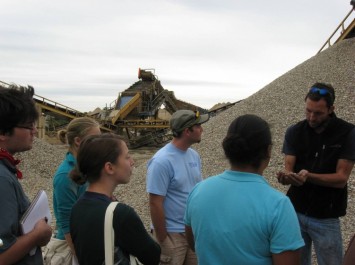 Having our watershed as the unit of study reinforced the importance of a sustainability movement that took into account all the interests and perspectives of the wide span of people who lived within the region. We aimed to introduce students to as many diverse actors in the watershed as possible, providing opportunity for students to interact freely and directly with our hosts.
Having our watershed as the unit of study reinforced the importance of a sustainability movement that took into account all the interests and perspectives of the wide span of people who lived within the region. We aimed to introduce students to as many diverse actors in the watershed as possible, providing opportunity for students to interact freely and directly with our hosts.
We believed that face-to-face encounters with real people would provide the most transformative experiences in this program. Faculty and staff discussed the nature of our upcoming conversations with hosts in advance. We clearly stated that we were interested in hearing their personal journeys in sustainability, and we provided in advance the types of questions to be asked in our visit. It was important for our hosts to tell their stories in ways that the students could connect to them as members of our watershed community, not simply as experts or as purveyors of knowledge. We sought to learn from our hosts about their own paths on sustainability, about progress they have experienced over time, and their own stories of how they came to believe and invest in sustainability—or what prevented them from doing so. We asked questions about critical incidents that influenced the course of their path, and the roadblocks and setbacks they have experienced along the way.
In preparation for each meeting, our hosts provided background material on their organizations and initiatives. This was a critical step toward moving the conversation beyond information transfer toward the personal level of conversation we sought; knowing the background enabled students to get beyond “What do you do?” to ask deeper and sharper questions about why and how. We allocated time, usually on the morning after the day-long field trips, for group reflection on the experiences and conversations contained in the trips. This debrief was structured around two or three core questions that linked the perspectives of the field trip host or the content of their work to the material that our courses had been covering so far. In this way, we aimed not only to help students connect the content learning that was “in-class” with “out-of-class” content, but to clearly identify for the students the various hosts as experts in their own right on these sustainability topics. As the semester progressed, students grew notably in their ability to cite discussion and phrases from our hosts as key to their emerging understandings. Engaging with real people highlighted the complexity of the issues while giving hope through helping students see our shared humanity. Below, we share our assessments of how this approach contributed to student learning, based on faculty notes and excerpts of student writing.
Encounters with difference: Developing empathy, understanding, and communication skills
In a society that increasingly inhabits indoor and online spaces, moves itself by private vehicle travel, lives segregated along economic lines, and uses selective media inputs, people can easily avoid personal encounters with others, particularly those who are different from themselves or with whom they may disagree. In our largely rural, politically conservative context, environmental uses and priorities are among the common social dividers, as they have become intertwined with a highly polarized political package. Enabling communication across these divides is a critical part of moving toward regional sustainability.
We made special effort to ensure that our self-selected Sustainability Semester students would have ample opportunities to encounter people with a wide spectrum of values and practices. Two students took the initiative to write about their experiences for the College newspaper. They focused on these encounters with difference as pivotal learning experiences, helping them develop both empathy and understanding from unexpected sources:
“I entered the Sustainability Semester expecting to learn from environmentalists like those you’d find in the Goshen College community since we’d be taking weekly field trips to interview people on environmental topics. I quickly realized that conservative pastors, industrial-scale farmers and a manager of a gravel pit, among others, could teach me just as much about these issues. It was then that I knew the Sustainability Semester would broaden my understanding of the complexity of environmental problem solving.
“I thought it would be a fun and easy semester … However, SSR was not at all what I expected. It was a challenging program that allowed me to realize my own prejudices and discover what it meant to be a member of this local and global community.
“Throughout the semester, we had the opportunity to have conversations with over 130 people, ranging from those for whom ‘environment’ was a dirty word to nature-loving hippies. Our experiences throughout 300 hours of learning outside of the classroom at 60 different sites taught us to recognize the limitations in our own biases and more fully appreciate the blurring of opposing sides. It’s hard to call one side good and the other bad in absolute terms.
“One of the characters we met was the owner of a Michigan gravel pit. We went into the conversation with the mindset that a gravel pit isn’t the pinnacle of sustainability, but our sense of superiority quickly crumbled. We discovered that the owner had high moral standards and he carefully considered the ethics of each social and environmental decision. One conversation after another, our assumptions of sustainability as a two-sided issue dissolved and we learned the importance of allowing everyone to participate in discussions of environmental issues and solutions.”
-The Goshen College Record, January 2012
These encounters with difference prompted students to reflect about how they could communicate across ideological divides. In their field notebooks, they each noted in detail the surprisingly eco-friendly actions mentioned by the gravel pit operator—to later relate to their environmentalist friends: “this man and his passion allowed me to see and to appreciate the other side.” Hearing about the realities of environmental decision-making from a government official increased student understanding for the plodding pace of political progress. A church leader confiding his personal interest in sustainable practices—but explaining that the politically charged context made him refrain from raising these issues from the pulpit—prompted students to consider what approaches might be suitable for including these congregations in watershed sustainability. Students wrote that promoting sustainability in these church contexts would require presentation in a way that matched the culture and the expected language of the church.
Looking in the mirror: Introspective critique of self and meeting role models
Some of the students’ strongest reactions were reserved for the individuals most involved in classic sustainable practices such as municipal planning and green technologies. It caught them by surprise to discover their own reactions against those whom they expected to be their natural allies in sustainable living. Their instinctive critiques were often based on students’ concern for social justice: Why didn’t the large planning board include any people of color? Wouldn’t their efforts reinforce the town’s creeping gentrification? Wasn’t this green industry all centered around assuaging the guilty consciences of the super-wealthy? How does green technology industry challenge our nation’s hyper-consumerism, which is at the core of so many of our environmental problems? Students noted that “even though we criticize [this] lifestyle, we have a lot of similarities in our lifestyles,” and “we hate…because we are a lot like [this]”; “maybe [they] bothered us because [they] remind us of ourselves.” Students were able to link their criticism of others to their own frustrations with failing to live up to their own sustainability ideals.
It was equally important that among our interactions, students found a number of individuals whom they felt they could emulate, and whose journeys in sustainability students could perceive as somehow analogous to their own. One student wrote, “Sustainability has different definitions and is changing all the time. It was nice to receive some of those definitions from different people from all types of jobs.” Often, it was these individuals’ honest stories about their own shortcomings, doubts, and failures that created this resonance. One organizational director described how writing a grant application brought into relief the imbalance between the ethnic diversity on his institution’s board and that of the community members whom the organization served, prompting him to create a board reflecting the demographic of his constituency. The organization has pioneered small discussion clusters composed of people hand-picked to participate because they hold opposing views on identified topics, with the goal of improving understanding, overcoming prejudice, and finding a way to make their future together. Students took note of his challenging question: “How do we approach people with curiosity instead of judgment?”
Students heard this objective and strategy of drawing together disparate groups to “create a better future together” repeated in meetings with regional planning commissioners around water management, restaurant owners around developing local foodsheds, and urban housing providers around shelter advocacy. These initiatives humanized problems and humanized the actors who would have to contribute to local solutions. In student writing and discussions, students caught a vision for this approach of intentionally bringing very different types of people together to work through issues that concerned them all. Although their residence in the College’s town is temporary, students came to see themselves as part of building sustainability in this place: “Though the contribution of my labor to plant trees gave me no direct personal gain…it does benefit me by providing a role for me in the community.”
Creating a better future together: Putting ideals into practice
The direct encounters with diverse actors in the watershed taught students that working on issues of local environmental importance required attention to matters of inclusion, trust, and communication. In the program’s capstone Environmental Problem Solving course, students worked with several different local groups to forward emerging initiatives that those groups were developing. Although they certainly brought a large amount of their specific content knowledge to the work, each of the groups discovered the importance of communicating with and including multiple audiences and stakeholders in their projects’ outcomes. Drawing on the approaches they had witnessed through interactions with diverse actors in the watershed, they framed their projects with the understanding that sustainability initiatives need to cast a wide social net. They were also attentive to issues of communication as they developed proposals and publicity materials, anticipating potential concerns of constituents. The effort students spent on establishing communication and support for their projects may in fact be one of the more enduring results of their time in the semester, as they now all have a rich understanding of the effort involved in collaboration, but also feel empowered to set up collaborations in any future setting they find themselves in. During a verbal program evaluation, several students noted that the program enabled them to know how to start building a coalition around a situation requiring coordination among multiple groups, and also gave them confidence to approach and to reach out to the range of people involved in making and implementing decisions.
Students began to recognize the need to understand alternative perspectives enough to find a common language. Differing use and meanings of words is often a real-world obstacle to meaningful dialogue amongst different community groups that is not realized or addressed in a classroom setting. One student suggested that to communicate with those long resistant to sustainability messages, we “must become family” and “communicate in their language.” Students desired to find ways to dialogue with people of different perspectives to aid in mutual understanding and collaboration. We held an end-of-program reflection on what students had learned about environmental communication from how the people we met communicated their own views. In the session, students named the insight-giving person or interaction as they generated the following principles for successful communication about sustainability:
- Speak their language, write/speak with your audience in mind.
- Communicate that change can happen.
- Demonstrate a new way. In person. Hands on. Visit.
- Discover and talk about shared experiences and values.
- Share food! Good reminder of a common need.
- Put aside your agenda to draw in others’ interests. Find consensus. Bring (invite!) people in.
- Attract – don’t repel.
- Work close to the ground. Live what you work. Take action where you live.
- Communicate across levels, i.e. chains of command.
- Assign tasks.
- Lead by example. Walk the talk.
- Do what you do well and people will notice.
- Keep moving.
- Have/find/create a supportive community that shares your vision. Cultivate friendship.
- Keep communication open to your foes.
- Cling to hope!
- Live your values. But realize and honor the humanity of all. Love your ideological enemies, too.
- Do all you can in your own sphere of influence.
- Acknowledge your part in what goes on.
- Don’t rely on fear – it’s fleeting. Fear doesn’t motivate.
- Save your graphics for the positive.
- Visual is essential! Paint picture with words and use images.
- Actively listen to people on all sides – body language is important!
- Don’t interrupt – let people have their say.
- Structure conversations – “talking stick”.
- Believe that good news is good for all! Everyone! Every single one.
- Frame the issue – shape the conversation.
- Don’t give up on anyone.
From the faculty perspective, we needed to grapple with certain limitations inherent in a field-based semester program of this type. Our program included multiple faculty present in each class session and most faculty present for the field trips, which entailed a much greater time commitment than typical classroom teaching. Having broad faculty presence across most field activities meant that students could seamlessly draw examples and lessons from one unit into the topics in a subsequent unit; however, this would not have been possible without significant commitment to interdisciplinary learning among all our faculty, and the deliberate course integration in the program design years preceding program implementation. The residential nature of the program, which provided ample opportunities for students to put their new learning about community building into practice, also limited involvement by students unable to be away from other commitments on campus or at home. We also found that having a sufficient number of students participating was critical for this program that relied so directly on student input and interaction. Within Goshen College, the Sustainability Semester in Residence serves as part of one track in existing science majors, and on its own can form the foundation for a minor for students in any discipline; this institutional framing is helpful in informing students about the program, and also provides a clear path to apply the academic credit earned in the semester.
Conclusion
The bedrock of social and environmental justice is learning to see all other people as equally human as ourselves, and to believe that their communities need to be as life-giving and beautiful as the environment in which we would choose to live. Yet many pressures in our contemporary society drive people in opposite directions, towards tending to stereotype the other and to minimize commonalities with them. Thus a crucial step in beginning to tackle justice in sustainability is to become aware of ways in which our similarities with many other types of people outweigh our differences. This awareness was elegantly captured by one of the students during a reflection on the Downstream Week canoe-and-visit experience:
“I have come to realize in a new way that there were no good or bad people on the trip, just people. Though they are unique in their passion, intention, and impact on the environment, they all share in the existence of humanity with all of its inherent limitations and heroism. I myself am transformed into someone who will get to know people more closely and openly before making judgments and who will continue…knowing full well of my own privilege and affluent lifestyle.”
Works Cited
Bonta, M. and C. Jordan. 2007. “Diversifying the American Environmental Movement.” In Diversity and the Future of the U.S. Environmental Movement, ed. E. Enderle, pp. 13-33. New Haven: Yale University School of Forestry and Environmental Studies. http://environment.research.yale.edu/documents/downloads/0-9/05-Bonta-and-Jordan.pdf
Bouma-Prediger, Steven. 2010. For the Beauty of the Earth: A Christian Vision for Creation Care. Second edition. Grand Rapids: Baker.
Chawla, L. and D.F. Cushing. 2007. Education for strategic environmental behavior. Environmental Education Research 13(4): 437-452.
Cronon, W. 1995. “The Trouble with Wilderness; or, Getting Back to the Wrong Nature.” In Uncommon Ground: Rethinking the Human Place in Nature, ed. W. Cronon, pp. 69-90. New York: W.W. Norton & Co.
Dewey, J. 1938. Experience and Education. Indianapolis, IN: Kappa Delta Pi.
Enderle, E., ed. 2007. Diversity and the Future of the U.S. Environmental Movement. New Haven: Yale University School of Forestry and Environmental Studies.
Hungerford, H.R. and T. Volk. 1990. Changing learner behavior through environmental education. Journal of Environmental Education 21(3): 8-21.
Lausanne Global Consultation on Creation Care and the Gospel, St. Ann, Jamaica, 9 November, 2012. Downloaded on January 3, 2013 from http://www.lausanne.org/en/documents/all/2012-creation-care/1881-call-to-action.html
Louv, R. 2012. Interview remarks in “Why not more Environmental Education in Schools?” workshop, Merry Lea Environmental Learning Center of Goshen College, November 12, 2012.
Louv, R. 2005. Last Child in the Woods: Saving Our Children from Nature-Deficit Disorder. Chapel Hill: Algonquin.
Moon, J.A. 2004. A Handbook of Reflective and Experiential Learning: Theory and Practice. New York, NY: RoutledgeFalmer.
Orr, D.W. 1994. Earth in mind: On education, environment, and the human prospect. Washington, DC: Island Press.
Pooley, J.A. and M. O’Connor. 2000. Environmental education and attitudes: emotions and beliefs are what is needed. Environment and Behavior 32(5): 711-723.
Sandler, R. and P.C. Pezullo, eds. 2007. Environmental Justice and Environmentalism: the Social Justice Challenge to the Environmental Movement. Cambridge, MA: MIT Press.
Saylan, C. and D.T. Blumstein. 2011. The Failure of Environmental Education (And How We Can Fix It). Berkeley and Los Angeles: UC Press.
Shephard, K. 2008. Higher education for sustainability: seeking affective learning outcomes. International Journal of Sustainability in Higher Education 9(1): 87-98.
Smith, A.M. and S. Pulver. 2009. Ethics-based environmentalism in practice: religious-environmental organizations in the United States. Worldviews: Global Religions, Culture and Ecology 13(2): 145-179.
[1] The Sustainability Semester in Residence (SSR) began operating its fall semester in 2012. Open to students of all majors and from any undergraduate program, the inaugural 2012 cohort included seven students from three undergraduate institutions.
[2] The courses were Landscape Limnology; Faith, Ethics and Eco-justice; Sustainability and Regeneration; Environmental Policy and Politics; and Environmental Problem Solving.







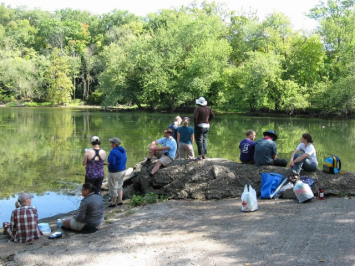
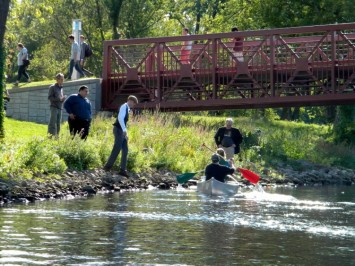
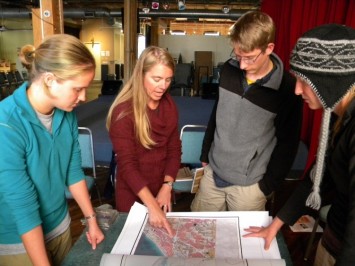



 Laura S. Meitzner Yoder enjoys teaching undergraduate and graduate field research methods and conducting research on human/nature relationships. Her work focuses on community land and forest management in mainland and Southeast Asia, field-based teaching about the commons, and cross-cultural aspects of environmental learning.
Laura S. Meitzner Yoder enjoys teaching undergraduate and graduate field research methods and conducting research on human/nature relationships. Her work focuses on community land and forest management in mainland and Southeast Asia, field-based teaching about the commons, and cross-cultural aspects of environmental learning.  Jonathon W. Schramm has a background in plant ecology and ecology education research, with the common thread of working to understand complex interconnections in both human reasoning and natural systems. He teaches environmental education and sustainability.
Jonathon W. Schramm has a background in plant ecology and ecology education research, with the common thread of working to understand complex interconnections in both human reasoning and natural systems. He teaches environmental education and sustainability.  Lisa R. Zinn teaches undergraduate and graduate classes, as well as working with environmental programs for elementary and high school age students. She shares her love of ornithology and field teaching with her students, and inspires them to learn about the intricacies and ecological importance of aquatic systems.
Lisa R. Zinn teaches undergraduate and graduate classes, as well as working with environmental programs for elementary and high school age students. She shares her love of ornithology and field teaching with her students, and inspires them to learn about the intricacies and ecological importance of aquatic systems. 
